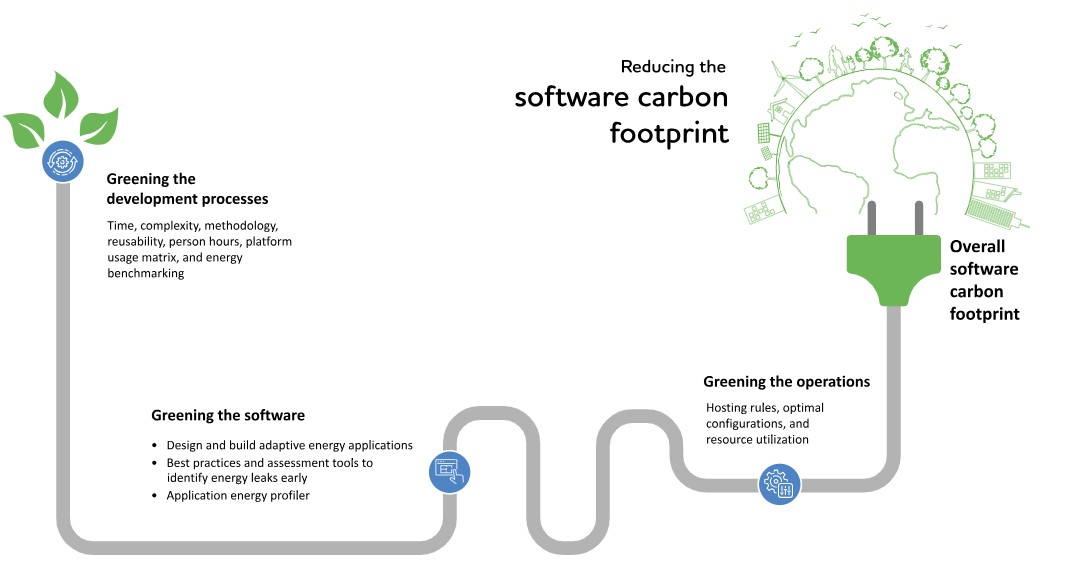
The goal of Net Zero
The ICT sector contributes approximately 2.1-3.9% of total global greenhouse emissions. While software currently has a lower carbon footprint compared to other sources, its emissions are expected to rise significantly due to the growth of digital transformation and AI applications.
To address this, organizations need to expand their sustainability efforts to include software, measuring its energy impact throughout development, deployment, operations, and maintenance stages. They can utilize tools like energy profiler tools and measurement frameworks to enhance decarbonization initiatives to achieve net-zero emission targets. These technologies not only aid in reducing carbon footprint but also enhance operational efficiency in the software development process.
Organizations aiming for net-zero emission targets prioritize decarbonization by evaluating all contributors to their carbon footprint, including application software. Measuring software energy consumption presents challenges as it can only be indirectly assessed in relation to the power used by accompanying hardware.
Understanding the complete carbon footprint of software entails analyzing its energy usage from development to deployment stages. By leveraging technologies and incorporating reusable components, organizations can streamline the software development process and overall operations, ultimately working towards emission reduction goals.
This perspective underscores the importance of greening software and introduces a framework for measuring software’s carbon footprint, offering recommendations and best practices to guide organizations in their emission reduction endeavors.
Expand The Scope of Sustainable It Through Green Software
With the growth of sustainable awareness and a general shift towards responsible environmental, social, and governance (ESG) practices, all organizations successfully determined the issue. However, there are not too many impossible and long-term solutions that can support the organization to approach the decarbonization goal.
So far, the focus of sustainable IT has primarily revolved around reducing energy consumption in data centers, optimizing heating and cooling, minimizing travel, and managing carbon offsets and e-waste. However, it is essential to include the energy consumed during software development and related operations to truly understand the organization’s overall carbon footprint.
While IT might not currently rank as one of the major contributors to carbon emissions, this perspective could shift in a few years due to the rapid growth of digital transformation initiatives and AI-driven applications.
In fact, research suggests that the Information and Communication Technology (ICT) sector may account for approximately 2.1–3.9% of global emissions, significantly higher than the previous estimate of 1.8–2.8%. Consequently, organizations need to broaden their perspective and assess the comprehensive impact of IT operations, particularly concerning application software.
Aspects of Green Software
Building “green” software involves improving efficiencies across the development process, deployment, usage, and maintenance. Organizations must put a framework in place to measure the carbon footprint and energy optimization throughout the software lifecycle.
Making the Development Process Eco-Friendly:
To make the development process more sustainable, organizations should focus on enhancing efficiency and measuring it throughout the development phase. Automation is crucial at every stage of software development and significantly contributes to the sustainability of traditional applications. It reduces development time and lowers carbon emissions by optimizing the use of IT systems and human resources. Techniques such as model reuse, sharing prebuilt models, model compression, and meta-learning can enhance energy efficiency in AI-based applications.
Organizations need to assess the required accuracy for each project and find a balance between precision and energy consumption. Utilizing configurable, domain-specific software products and platforms can accelerate the development process. Identifying elements in traditional applications that can be transformed into AI-based models will allow organizations to take advantage of energy-efficient accelerators.
To boost energy efficiency, applying energy benchmarking from the early development phases is essential. Tools like TPC-Energy and MLPerf emphasize energy efficiency and assist in optimizing energy consumption.
Greening Software Development:
Establishing guidelines and coding practices during development is crucial for creating high-performing, energy-efficient software. Implementing best practices and using assessment tools can enable large teams to produce greener software. Resource optimization is a key focus area, as it involves minimizing the use of processors, storage, network bandwidth, and time. Often, resources like disk space are overlooked throughout the software lifecycle. Batching multiple tasks can conserve energy, as long as it doesn’t compromise latency requirements.
Organizations should also explore shifting from cloud to edge computing when feasible to reduce reliance on central servers and decrease network traffic. Neuromorphic architectures represent a promising approach to minimizing energy consumption, as they facilitate low-latency, real-time processing of inputs and are estimated to enhance energy efficiency by at least 1,000 times.
Improving user experience also plays a role in making software products greener. Conducting a customer journey analysis to examine various paths taken by users and optimizing those paths can significantly reduce carbon footprints. Demand-shaping strategies that align demand with existing resources can further optimize network bandwidth usage.
Greening Operations:
Operations significantly impact an organization’s carbon footprint, primarily through infrastructure and human effort. Efficiently reallocating workloads to green hosting data centers using automated algorithms can effectively distribute loads across multiple data centers, while shared hosting can also lower the overall carbon footprint.
Software maintenance tends to increase carbon emissions due to the extended time and resources involved. Greening maintenance requires reducing the carbon footprint associated with upgrades, fixes, and enhancements.
Organizations must weigh trade-offs when deploying additional resources to speed up operations. It’s essential to consider efficient hardware utilization and dynamic resource provisioning during deployment while adhering to service-level agreements.
Creating a Carbon Footprint Measurement Framework for Software
Software indirectly consumes energy through its reliance on hardware and data transfers. Therefore, measuring its carbon footprint presents significant challenges. For instance, obtaining power logs from virtual environments is complicated because isolating individual virtual machines (VMs) from large VM farms proves to be difficult.
Additionally, cloud deployment limits the ability to estimate carbon footprints at the application level, while the adoption of serverless architecture further complicates the issue. While some degree of abstraction in predicting power based on resource utilization can be beneficial, it does not account for all factors. Hidden elements, such as network transfers and disk input/output activity, must also be considered. Furthermore, accounting for human effort introduces other supporting resources and logistics into the mix, thereby increasing complexity.
To address these challenges, a draft framework is illustrated below. This framework aims to measure energy consumption at various levels, ultimately leading to a more accurate assessment of an application’s carbon footprint. It employs a predictor to estimate energy consumption using data gathered throughout the software lifecycle.
By applying a geo-specific grid emission factor and utilizing fine-grained data, the framework effectively translates total energy consumption into a comprehensive carbon footprint measurement.

Predicting energy utilization at an early stage plays a crucial role in developing an effective action plan and minimizing the application’s carbon footprint. To support this effort, the framework will be built on a set of best practices and recommendations for adopting greener options. Additionally, it will feature a mechanism to record baseline measures and establish improvement targets. The framework encompasses the following components:
1. Data Analysis: This involves examining various factors such as time, complexity, methodology, and platform usage to assess energy consumption during the development process.
2. Application Profiler: This tool optimizes software for energy utilization by focusing on design and construction, thereby facilitating the establishment of an energy budget for applications.
3. Evaluation of Deployment and Maintenance Methodologies: This includes analyzing hosting rules, determining optimal configurations, and assessing resource utilization to ensure efficient operations.
PROGRESSING TOWARDS GREENER SOFTWARE
When organizations set out on the journey toward achieving zero carbon emissions, they must first evaluate their current position and then formulate strategies for a sustainable future. Therefore, implementing a measurement framework serves as the initial step in creating an effective action plan.
This framework not only helps identify key contributing factors throughout the software value chain, but it also prompts organizations to conduct causal analyses and explore greener alternatives to maximize benefits. Furthermore, the detailed insights gained during the measurement phase enable organizations to pinpoint areas where the adoption of greener energy sources can be beneficial, as well as where energy-efficient applications can enhance performance.
Moreover, by qualitatively reducing their carbon footprint, organizations can significantly improve the metrics that influence ESG scoring, while also lowering operational costs. In addition, consolidating energy usage across the enterprise is crucial for accurately estimating the overall carbon footprint, especially since most data related to scope 2 and scope 3 emissions tends to be available only at an aggregate level.
Importantly, standardizing energy measurement across the industry represents a vital step toward enhancing energy efficiency. The insights obtained will facilitate benchmarking practices for industry reference and contribute to global decarbonization efforts.
Conclusion
As the ICT sector’s impact on global greenhouse gas emissions becomes increasingly significant, it is essential for organizations to expand their sustainability efforts to include the software lifecycle. By adopting comprehensive measurement frameworks and energy-efficient practices, companies can significantly reduce their carbon footprints. This journey toward greening software not only supports broader sustainability goals but also enhances operational efficiency and influences positive environmental, social, and governance (ESG) outcomes. Embracing these strategies will be critical for organizations aiming to fulfill their net-zero ambitions and contribute to a more sustainable future.


